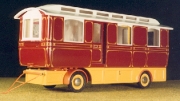LATE 1930s 24ft ROAD WAGON
 This was the first wagon that I built and it was started in 1994 from plans drawn up by Vic King for Model Fairground Designs. (plans are still available from Doug Roseaman Engineering) I had no idea what I was doing only that it was something that I really fancied building. The plans only covered the exterior in any detail but the interior was really left up to the modeller. I wrote to MFD to see if they could help with the interior layout but they suggested that I should find a full size wagon and see if the owner could help me. This turned out to be very good advice and started me on my long journey along the Wagon Trail.
This was the first wagon that I built and it was started in 1994 from plans drawn up by Vic King for Model Fairground Designs. (plans are still available from Doug Roseaman Engineering) I had no idea what I was doing only that it was something that I really fancied building. The plans only covered the exterior in any detail but the interior was really left up to the modeller. I wrote to MFD to see if they could help with the interior layout but they suggested that I should find a full size wagon and see if the owner could help me. This turned out to be very good advice and started me on my long journey along the Wagon Trail.
The best advice that I can offer anyone making a living wagon for the first time is precisely that which was given to me. Try to find a wagon similar to the one that you are going to make and study it in great detail taking loads of photos and measurements as you go. Find out how much of the wagon is original and how much the owner knows about any alterations that have been made over the years.
The MFD plans are quite good and the overall proportions are fine for a wagon of the late 1930s. I personally do not like working from plans as I prefer to make it up as I go along but these are fairly easy to follow so long as you work out in advance what changes you intend to make.
 I met John Harris from Ashington in West Sussex near where I live and he showed me around his lovely wagon (maker unknown), which is similar in shape and size to the plans. The main difference being that the entrance is into the kitchen and not the parlour as per the plans. This is a matter of choice and I decided to leave the door entering into the parlour.
I met John Harris from Ashington in West Sussex near where I live and he showed me around his lovely wagon (maker unknown), which is similar in shape and size to the plans. The main difference being that the entrance is into the kitchen and not the parlour as per the plans. This is a matter of choice and I decided to leave the door entering into the parlour.
John suggested that I contacted Julian Wolfe to get further advice and he (Julian) introduced me to John Pockett who is widely recognised as one of the leading authorities on Gipsy and Showmen's Living Wagons as well as being a first class wagon decorator.
I had already started on the model before I met John Pockett so I was not quite sure what he was going to find wrong with it but as it turned out, there was not too much.
The door should be changed to a stable type with the top half glazed and the bottom should consist of T-shaped panels. The windows at each end of the wagon should match and preferably be bays, not one plain and one bay as shown on the plan. The only other exterior alteration was to the main windows, which were considered to be too large. On the inside, the door from the parlour into the bedroom was moved from the centre of the wall to the left hand side as you face the bedroom. This gives room to build the bed lengthwise rather than across the width of the wagon. The majority of wagons have the bed lengthwise and this is not possible if the door is in the centre.